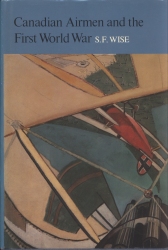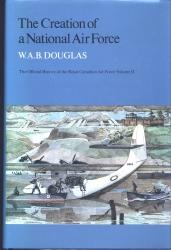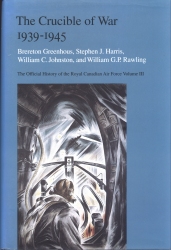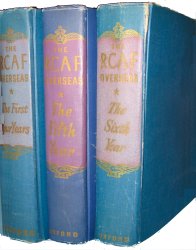Guide to Sources for Research into the Royal Canadian Air Force
Major works
In the writing of these volumes the authors had access to relevant official documents; however, the inferences drawn and the opinions expressed are those of the authors themselves, who are responsible for their reading or presentation of the facts as stated.

Canadian airmen and the first World War : S.F. Wise (Toronto, University of Toronto Press in co-operation with the Dept. of National Defence and the Canadian Govt. Pub. Centre, Supply and Services Canada, 1980)
This is volume 1 of The Official History of the Royal Canadian Air Force. It provides the definitive story of Canadian airmen in World War I and, moreover, a revisionist account of the war in the air. Organized topically, this volume begins with an overview of military aviation in Canada prior to 1914, as successful aircraft experiments like Baldwin's and McCurdy's Silver Dart are set against Defence Minister Sam Hughes' rejection of any government air policy. Financial timidity and political uncertainty subsequently decreed that the 20,000 Canadians who trained for, or fought in, history's first air war would have no air force of their own but would fly in the British flying services. The sections which follow show that Canadians excelled in every aspect of the air war. Indeed, although the First World War never saw an exclusively Canadian squadron in action and no Canadian rose to a command above Group level, Professor Wise has been able to write a full account of the war in the air from the Canadian perspective. Recruitment and training, the maritime air war, the strategic bombing of Germany and the defence of Great Britain, as well as action on the Western Front, in Italy, and in Macedonia, are all covered in depth. Each section reveals the complexity of air operations, as tactics, strategy, and aircraft evolved with astonishing speed. The exploits of remarkable fighter aces such as Billy Bishop, Raymond Collishaw, D.R. MaccLaren, and W.G. Barker, and of bomber leaders like R.H. Mulock, are set in the context of the air war and the many thousands of Canadians who served with them. In his conclusion Wise traces the development of Canadian government air policy to the year 1920, during which time the first Canadian air force was born and quickly died. In analysing this major step in Canada's entry into the air age he lays the foundation for postwar civil expansion and the formation of the RCAF. Illustrated with specially prepared colour and sketch maps and over 200 photographs, many of them published here for the first time, this book should prove invaluable to the military historian and of wide appeal to the aviation enthusiast and general reader alike.

The creation of a national air force : W.A.B. Douglas (Toronto, University of Toronto Press in co-operation with the Dept. of National Defence and the Canadian Govt. Pub. Centre, Supply and Services Canada, 1986)
This is the second volume of The Official History of the Royal Canadian Air Force. From a small militia organization the Canadian air force had grown by 1945 into one of the country's three major autonomous military services. In this second volume of the RCAF's official history, covering the years from 1918 to 1945, W.A.B. Douglas chronicles the force's rapid growth and provides a vivid portrait of the Battle of the Atlantic as it was fought from the eastern shores of Canada. Military necessity had brought Canada into the air age. In the peaceful 1920s, civil more than military concerns governed the shape, size, and functions of the RCAF; in the following decade the rise of international tensions forced the service to concentrate on its military role. During the Second World War the RCAF grew from a few hundred airmen to a force of some eighty squadrons and nearly a quarter of a million people . RCAF squadrons, wings, and groups took their place beside other Allied air forces in many theatres of the Second World War, and in the process acquired capabilities in virtually every phase of air warfare. The roots of the RCAF's growing reputation in overseas theatres, especially in the Northwest Europe campaign, were to be found at home. Responsible for the British Commonwealth Air Training Plan in Canada, the RCAF trained large numbers of other Commonwealth and Allied air men as we ll as Canadians. Charged with the air defence of Canada, it built up a big Home War Establishment which fought on the Pacific Coast and also played a significant part in the defeat of enemy attempts to destroy Allied shipping, particularly in t he Battle of the Atlantic. The latter was a crucial role, sustaining Great Britain and the Allied forces in Europe. Directed from headquarters at Halifax, aircraft of Eastern Air Command ranged from the St Lawrence River to mid-ocean, ultimately thwarting German U-boats that nearly severed the North Atlantic under British Command. Douglas's account is the first to give proper credit to the RCAF for the part it played in these operations. It also incorporates new information on personalities, technology, and intelligence.

The crucible of war, 1939-1945 : Brereton Greenhous, William R. Constable (Toronto, University of Toronto Press in cooperation with the Dept. of National Defence and the Canadian Govt. Pub. Centre, Supply and Services Canada, 1994)
This is the third volume of The Official History of the Royal Canadian Air Force. The Crucible of War is divded into five parts: Air Policy, the Fighter War, the Maritime Air War, the Bomber Air War, and the Air Transport War. The authors break new ground by deomstrating the influence of senior RCAF officers in shaping the execution of Canadian air policy, and they show how senior RCAF officer were permitted to determine the pace of Canadianization of the RCAF. Many operations are described in detail from a wide variety of documentary sources, among them the unsuccessful battle of attrition that resulted from Fighter Command's offensive over France in 1941-42, and the actions of the RCAF's No 83 Group in Second Tactical Air Force, which provided air support for the British Second Army. Overdue notice is accorded the anti-shipping strike squadrons of Coastal Command. No 6 Group's battle with German night-fighters is recounted within the framework of complex electronic measures and counter-measures developed by both sides.

The R.C.A.F. overseas : in three volumes, Toronto, Oxford University Press, 1944, 1945 and 1949. The first volume is sub-titled: "The First Four Years" covering the period February 1940 to August 1943, with a foreword by C.G. Power; the second is sub-titled: "The Fifth Year" covering the period September 1943 to August 1944, with a foreword by Colin Gibson; the third is sub-titled: "The Sixth Year" covering the period September 1944 to the Armistice, with a foreword by Brooke Claxton. All three volumes contain a Roll of Honour.
The first two volumes were produced during the war, the third a few years later; the authors are not named, but the preface to volume 3 states that "The Historical Section of the R.C.A.F. wished to express its appreciation for the help received from those many officers and men who compiled and kept so faithfully the records upon which these three volumes have been founded." These volumes may thus be considered official histories, but lack some detail given the wartime and immediate post-war public restrictions to some documents.
